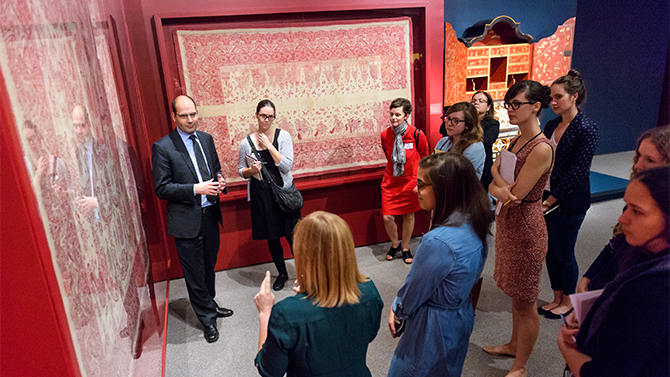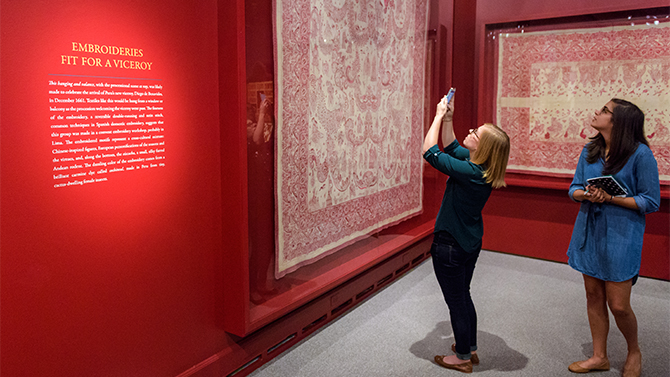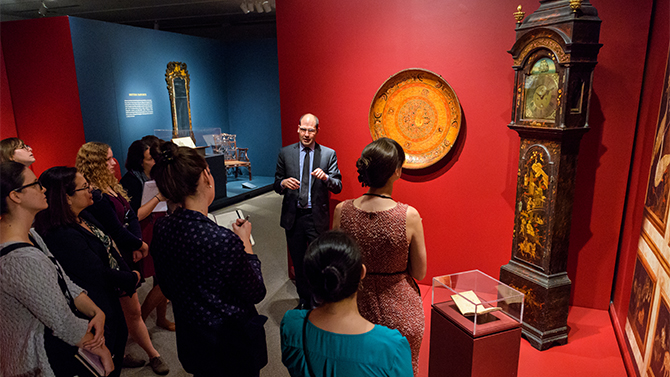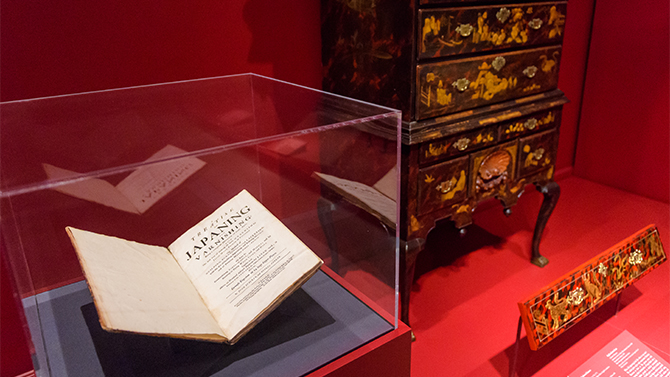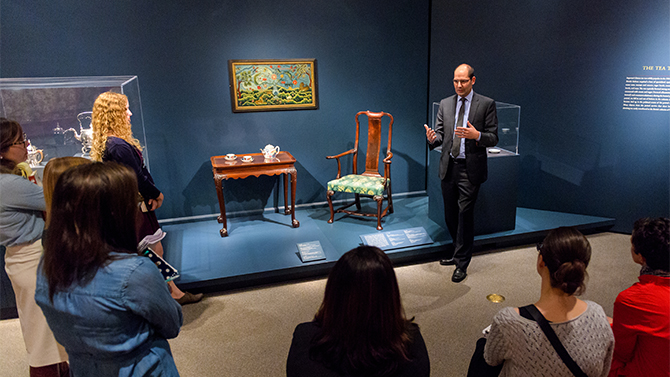

Connections through objects
Photos by Evan Krape November 04, 2016
Exploring roots of global trade in early Americas through Winterthur exhibition
If you happened to wander into the exhibition gallery at the Winterthur Museum, Gallery and Library in Wilmington, Delaware, on a certain Thursday afternoon in early October, you would have been greeted with the sight of a group of students and their teachers crouched on the floor in front of an image of St. Michael made out of feathers.
And you would have heard their collective gasp as a man in a suit and tie lit the image with the flashlight on his phone, turning it into a dazzling display.
The feather painting was created in Mexico in the late 16th century and the man in the suit was Dennis Carr, who curated the exhibit “Made in the Americas: The New World Discovers Asia” first at the Museum of Fine Arts in Boston, where he works as the Carolyn and Peter Lynch Curator of American Decorative Arts and Sculpture, and then at Winterthur. Carr graduated from the University of Delaware’s Winterthur Program in American Material Culture in 1999.
“The feathers don’t really lose their color or iridescence over time,” Carr told the students. “The color comes from the crystalline structure of the feather itself. It’s not like a dye that can fade. So it is probably almost as vibrant as it looked initially.”
A lively conversation followed about the glue used to hold the feathers to the paper underneath, the provenance of objects like this one – which turned up at an auction in England, piracy on the high seas, the date the painting was entered in the Prague inventory of the Holy Roman Emperor (1607) and how it would look next to contemporaneous European-produced images of native Americans in feather headdresses.
And that was just in the first 15 minutes of class.
‘Objects in Motion’
Carr assembled an extraordinary exhibit full of objects influenced by Asia but created in the Americas in the 17th through 19th centuries in a geographic swath that stretches from New England to Peru.
“I was trying to think of an exhibition that would look broadly across the hemisphere in the Americas. And I wanted to do a colonial exhibition,” Carr said. “And I was sitting there thinking to myself what’s the common thread between all these different regions, linking Quebec City to Boston to Mexico City to Lima? What’s the link between all of these different places that didn’t necessarily trade with each other or communicate with each other and that were all being governed by different, often competing, European powers? And then it occurred to me that they were all trading with Asia at the same time. And the trade with Asia has a major impact on the art production throughout the hemisphere. So that’s the thread for the show.”
That theme was a perfect match to the research and teaching interests of UD art history professors Wendy Bellion and Mónica Domínguez Torres, who have twice before co-taught the graduate course “Objects in Motion: The Early Americas.” But never before have they or their students had the opportunity to get so up close and personal with the objects they are studying as this fall, when their work has focused on the Winterthur exhibition.
And according to Domínguez Torres it’s a noticeable difference. “Other times we have asked [our students] to think about how to create an exhibition that will present to larger audiences the kinds of issues that we talk about in class of exchange and circulation and so on…and then they have to take objects that are from books basically. So it’s not the kind of real, tangible thing,” she said.
“This is the other way around. We have the objects and they have to relate the objects to the larger kind of issues and questions that we have been exploring in class, which is great.”
Each student in the course is writing a scholarly paper growing out of study of an object in the exhibition. And because many of them plan to work in the museum field, where speaking to a non-specialist audience is an important skill, Bellion and Domínguez Torres are working with Winterthur to set aside a few afternoons in early December where the students will do short public gallery talks about the object that they selected.
“We’re always lucky to have Winterthur at our backdoor; the collections and curators are so welcoming there,” said Bellion, “but it’s a rarity to have this particular constellation of objects. I think it really underscores the importance for anyone who does material culture or any kind of cultural history in the arts to have access to an extraordinary collection. I think it enhances how the students learn. They ask different kinds of questions. It leads them to produce much more refined results as a consequence”
Collaborative learning
In addition to having access to all of the objects in the exhibition and the assistance of Winterthur’s staff, students in the class also had the unique opportunity to spend time in the exhibition with Carr.
“Being able to speak with the curator of the exhibition was invaluable,” said Sabena Kull, a doctoral student in art history. “As someone who wants to work as a curator in the future, it was very enlightening to hear Dennis talk about some of the ‘behind the scenes’ issues involved in putting the exhibition together, both the successes and the struggles. Dennis was also gracious in sharing the research that he and his curatorial team, as well as past researchers, had already done.”
As the class moved through the exhibition, Carr offered insights of many different varieties, providing historical context, explaining what materials were used in the creation of the objects and their origin and significance and spinning some great yarns about how he came across the objects in the first place (one painting involved visiting multiple homes in Mexico, much conversation, and “many drinks”).
Emilie Gavalt, a master’s degree student in the Winterthur Program in American Material Culture, is studying a sketchbook of baroque and chinoiserie designs created by the French painter Jean Berger. She said that Carr helped her “place the sketchbook in context as some of the only surviving material demonstrating the design process behind 18th century Anglo-American chinoiserie objects, in this case, most likely japanned furniture.” She also appreciated that Carr made himself available for follow-up questions and offered helpful bibliographical suggestions and ideas for further scholarly contacts.
And there is no question in the students’ minds about the value of doing research with direct access not only to the curator, the Winterthur staff and their teachers but the very objects they are studying as well.
“Overall I would say that using the Winterthur exhibition has been a tremendous help throughout this course because it allows us to grasp the precise materiality of the objects that were being circulated throughout the Americas,” Anne Cross, a doctoral student in art history, said. “By seeing them in person, we can get a better sense of the color, weight, size, and brilliance of the objects, and therefore come closer to understanding how they affected and impacted their consumers. I was knocked off my socks when I first saw some of the objects in the exhibition and I can only imagine that people in the seventeenth and eighteenth centuries had a similar experience.”
“Made in the Americas” is on view at the the Winterthur Museum, Gallery and Library until Jan. 8, 2017.
Contact Us
Have a UDaily story idea?
Contact us at ocm@udel.edu
Members of the press
Contact us at 302-831-NEWS or visit the Media Relations website

